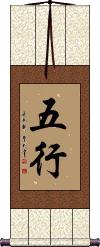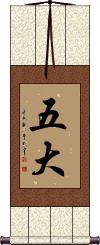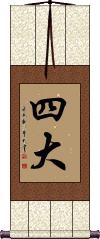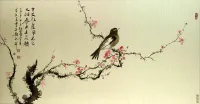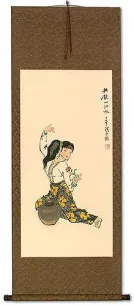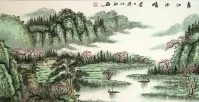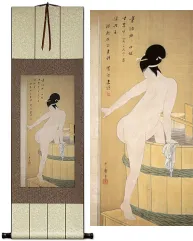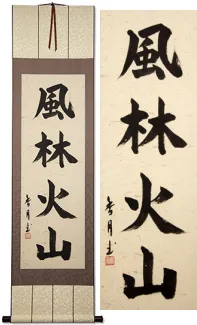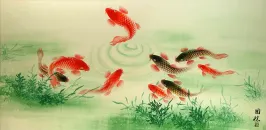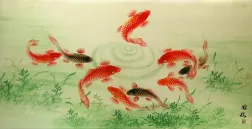Many custom options...
And formats...

The name Fire Earth Water in Chinese / Japanese...
Buy a Fire Earth Water calligraphy wall scroll here!
Personalize your custom “Fire Earth Water” project by clicking the button next to your favorite “Fire Earth Water” title below...
Five Elements
五行 is the title of the five elements: wood, fire, water, earth, and metal.
The first character means five, and the second character is simply element(s).
According to ancient Chinese science, all matter in the world is comprised of these elements. One idea presented with the five elements is that when energy is added, the matter is believed to expand. When energy is removed, matter contracts. Oddly, this concept is not far from Einstein's theories and modern science. Just a few thousand years before Einstein.
More info: Wikipedia - Five Elements (Wu Xing).
See Also: Wood | Fire | Water | Earth | Metal | Five Elements
Five Elements
金木水火土 is a list of the Chinese characters for the five elements in a comfortable order (meaning that they “feel right” to a Chinese person who views this arrangement).
The order is metal, wood, water, fire, and earth.
Note that sometimes the metal element is translated as gold. And earth refers to soil versus the whole planet earth.
Five Elements
地水火風空 is the specifically-Japanese version of the five elements.
This is a little different than the ancient or original Chinese version.
The elements are written in this order:
1. Earth / Terra / Ground
2. Water
3. Fire
4. Wind / Air
5. Sky / Emptiness / Void / Ether
Note: This set of Kanji can also be romanized as “ji sui ka fuu kuu,” “jisuikafuukuu,” or “jisuikafuku.”
These can also be written in the order 地火風水空 (chi ka sui fuu kuu). Let me know when you place your order if you want the Kanji to be in this character order.
Four Elements
Buddhist Term
地水火風 is a Buddhist term that means “earth, water, fire, wind.”
This is often just referred to as “the four elements.” There is a more common title (the five elements) that adds wood to the mix. These four elements are used in some sects of Japanese Buddhism (not so much in Chinese).
Godai / Five Elements
五大 is the Japanese title for the five elements.
In Japan, the five elements differ slightly from the original Chinese. Therefore, in Japanese philosophy, you have earth, water, fire, wind, and void (space).
The meaning of the first character is 5, but the second character means great or large. Some translate this as the five majors. 大 is only understood as “elements” when you have 五 in front of it.
In Buddhism, this can be short for 五大明王, or the five great and wise kings.
Shidai / Sida / Mahabhuta
In Mahayana Buddhism, 四大 represents mahābhūta, the four elements of which all things are made: earth, water, fire, and wind.
This can also represent the four freedoms: speaking out freely, airing views fully, holding great debates, and writing big-character posters.
In some contexts, this can be a university or college offering four-year programs.
To others, this can represent the Tao, Heaven, Earth, and King.
Going back to the Buddhist context, these four elements “earth, water, fire, and wind,” represent 堅, 濕, 煖, 動, which are: solid, liquid, heat, and motion.
Earth Fire Water Air
This in-stock artwork might be what you are looking for, and ships right away...
Gallery Price: $322.00
Your Price: $178.88
Gallery Price: $144.00
Your Price: $79.88
Gallery Price: $240.00
Your Price: $98.88
Gallery Price: $400.00
Your Price: $138.88
Gallery Price: $400.00
Your Price: $138.88
Gallery Price: $121.00
Your Price: $66.88
Gallery Price: $200.00
Your Price: $122.88
Gallery Price: $72.00
Your Price: $39.88
Gallery Price: $448.00
Your Price: $248.88
Not the results for fire earth water that you were looking for?
Below are some entries from our dictionary that may match your fire earth water search...
| Characters If shown, 2nd row is Simp. Chinese |
Pronunciation Romanization |
Simple Dictionary Definition |
五大 see styles |
wǔ dà wu3 da4 wu ta godai ごだい |
More info & calligraphy: Godai / Five ElementsThe five elements— earth, water, fire, wind, and space. v. also 五行 the five agents. In the esoteric cult the five are the physical manifestation, or garbhadhātu, v. 胎; as being in all phenomena they are called 五輪 the five evolvers; their phonetic embryos 種子 are those of the Five Dhyani-Buddhas of the five directions, v. 五佛. |
五行 see styles |
wǔ xíng wu3 xing2 wu hsing gogyou / gogyo ごぎょう |
More info & calligraphy: Five Elements(1) (See 五大・ごだい・1) the five elements (in Chinese philosophy: wood, fire, earth, metal and water); the five phases; wu xing; (2) {Buddh} five practices of the Bodhisattvas; (3) (See 六信五行) the five pillars of Islam; (surname, given name) Gogyou The five lines of conduct. I. According to the 起信論 Awakening of Faith they are almsgiving; keeping the commandments; patience under insult; zeal or progress; meditation. II. According to the 涅槃經 Nirvana Sutra they are saintly or bodhisattva deeds; arhat, or noble deeds; deva deeds; children's deeds (i. e. normal good deeds of men, devas, and Hinayanists); sickness conditions, e. g. illness, delusion, etc.; — into all these lines of conduct and conditions a Bodhisattva enters. III. The five elements, or tanmātra— wood, fire, earth, metal, and water; or earth, water, ire, air, and ether (or space) as taught by the later Mahāyāna philosophy; idem 五大. |
四大 see styles |
sì dà si4 da4 ssu ta shidai しだい |
More info & calligraphy: Shidai / Sida / Mahabhuta(1) {Buddh} the four elements (earth, water, fire, wind); (2) the human body; (3) Tao, heaven, earth and king mahābhūta, 四界; 四大界. The four elements of which all things are made; or the four realms; i. e. earth, water, fire, and wind (or air); they represent 堅, 濕, 煖, and 動 solid, liquid, heat, and motion; motion produces and maintains life. As 實 active or formative forces they are styled 四界 (四大界) ; as 假 passive or material objects they are 四大; but the 成實論 Satyasiddhi śāstra disputes the 實 and recognizes only the 假. |
毒蛇 see styles |
dú shé du2 she2 tu she dokuja; dokuhebi どくじゃ; どくへび |
More info & calligraphy: Viperpoisonous snake; poisonous serpent A poisonous snake.; Poisonous snakes, the four elements of the body— earth, water, fire, wind (or air)— which harm a man by their variation, i. e. increase and decrease. Also, gold. |
四大元素 see styles |
yondaigenso よんだいげんそ |
More info & calligraphy: Earth Fire Water Air |
地水火風 地水火风 see styles |
dì shuǐ huǒ fēng di4 shui3 huo3 feng1 ti shui huo feng chisuikafuu; jisuikafuu / chisuikafu; jisuikafu ちすいかふう; じすいかふう |
More info & calligraphy: Four Elementsearth, water, fire, wind |
地水火風空 see styles |
chisuikafuukuu; jisuikafuukuu / chisuikafuku; jisuikafuku ちすいかふうくう; じすいかふうくう |
More info & calligraphy: Five Elements |
印 see styles |
yìn yin4 yin in いん |
to print; to mark; to engrave; a seal; a print; a stamp; a mark; a trace; image (1) stamp; seal; chop; (2) seal impression; seal; sealing; stamp; mark; print; (3) {Buddh} mudra (symbolic hand gesture); (4) ninja hand sign; (5) (abbreviation) (See 印度・インド) India; (surname) In mudrā; seal, sign, symbol, emblem, proof, assurance, approve; also 印契; 契印; 印相. Manual signs indicative of various ideas, e. g. each finger represents one of the five primary elements, earth, water, fire, air, and space, beginning with the little finger; the left hand represents 定 stillness, or meditation, the right hand 慧 discernment or wisdom; they have also many other indications. Also, the various symbols of the Buddhas and Bodhisattvas, e. g. the thunderbolt; cf. 因.; (度) The five Indias, or five regions of India, idem 五天竺 q. v. |
大 see styles |
dài dai4 tai dai だい |
see 大夫[dai4 fu5] (pref,adj-na,n) (1) large; big; great; huge; vast; major; important; serious; severe; (prefix) (2) great; prominent; eminent; distinguished; (suffix) (3) -sized; as big as; the size of; (suffix noun) (4) (abbreviation) (See 大学・1) university; (5) large (e.g. serving size); large option; (6) (abbreviation) (See 大の月) long month (i.e. having 31 days); (given name) Yutaka Maha. 摩訶; 麼賀. Great, large, big; all pervading, all-embracing; numerous 多; surpassing ; mysterious 妙; beyond comprehension 不可思議; omnipresent 體無不在. The elements, or essential things, i.e. (a) 三大 The three all-pervasive qualities of the 眞如 q.v. : its 體, 相 , 用 substance, form, and functions, v. 起信論 . (b) 四大 The four tanmātra or elements, earth, water, fire, air (or wind) of the 倶舍論. (c)五大 The five, i.e. the last four and space 空, v. 大日經. (d) 六大 The six elements, earth, water, fire, wind, space (or ether), mind 識. Hīnayāna, emphasizing impersonality 人空, considers these six as the elements of all sentient beings; Mahāyāna, emphasizing the unreality of all things 法空, counts them as elements, but fluid in a flowing stream of life, with mind 識 dominant; the esoteric sect emphasizing nonproduction, or non-creation, regards them as universal and as the Absolute in differentiation. (e) 七大 The 楞嚴經 adds 見 perception, to the six above named to cover the perceptions of the six organs 根. |
色 see styles |
shǎi shai3 shai shoku しょく |
(coll.) color; used in 色子[shai3 zi5] (counter) counter for colours; (female given name) Shiki rūpa, outward appearance, form, colour, matter, thing; the desirable, especially feminine attraction. It is defined as that which has resistance; or which changes and disappears, i. e. the phenomenal; also as 顯, 形 and 表色 colour and quality, form or the measurable, and mode or action. There are divisions of two, i. e. inner and outer, as the organs and objects of sense; also colour and form; of three, i. e. the visible object, e. g. colour, the invisible object, e. g. sound, the invisible and immaterial; of eleven, i. e. the five organs and five objects of sense and the immaterial object; of fourteen, the five organs and five objects of sense and the four elements, earth, water, fire, air. rūpa is one of the six bāhya-āyatana, the 六塵; also one of the five skandhas, 五蘊, i. e. the 色身. Keith refers to rūpa as 'material form or matter which is underived (no-utpādā) and which is derived (utpādā)', the underived or independent being the tangible; the derived or dependent being the senses, e. g. of hearing; most of their objects, e. g. sound; the qualities or faculties of feminity, masculinity, vitality; intimation by act and speech, space; qualities of matter, e. g. buoyancy and physical nutriment. |
輪 轮 see styles |
lún lun2 lun rin りん |
wheel; disk; ring; steamship; to take turns; to rotate; classifier for big round objects: disk, or recurring events: round, turn (counter) counter for wheels and flowers; (female given name) Run cakra; wheel, disc, rotation, to revolve; v. 研. The three wheels are 惑業苦illusion, karma, suffering, in constant revolution. The five are earth, water, fire, wind, and space; the earth rests on revolving spheres of water, fire, wind, and space. The nine are seen on the tops of pagodas, cf. 九輪.; The two wheels of a cart compared by the Tiantai school to 定 (or to its Tiantai form 止觀) and 慧 meditation and wisdom; see 止觀 5. Also 食 food and 法 the doctrine, i. e. food physical and spiritual. |
七大 see styles |
qī dà qi1 da4 ch`i ta chi ta shichidai |
Earth , water, fire, wind, space (or ether), sight, and perception 地, 水, 火, 風, 空, 見, 証識; cf. 大, 五大and 六境; 見大 and 六根; 識大 and 六識. |
七曜 see styles |
qī yào qi1 yao4 ch`i yao chi yao shichiyou / shichiyo しちよう |
the seven planets of premodern astronomy (the Sun, the Moon, Mercury, Venus, Mars, Jupiter, and Saturn) (1) {astron} the seven luminaries (sun, moon, Mercury, Venus, Mars, Jupiter and Saturn); (2) the seven days of the week The seven brilliant ones — the sun and moon, together with the five planets which are connected with fire, water, wood, metal, and earth. Their essence shines in the sky, but their spirits are over men as judges of their good and evil, and as rulers over good and evil fortune. The following list shows their names in Chinese and Sanskrit: Sun 日, 太陽; aditya 阿彌底耶 Moon月, 太陰; soma 蘇摩 Mars火星, 勢惑勞; aṅgāraka 盎哦囉迦 Mercury水星, 辰星; budha 部陀 Jupiter木星, 歳星; bṛhaspati 勿哩訶娑跛底 Venus金星, 太白; śukra 戌羯羅 Saturn土星, 鎭星; śanaiścara 賖乃以室折羅. |
三金 see styles |
sān jīn san1 jin1 san chin mikane みかね |
(surname) Mikane The three metals, gold, silver, copper. The esoterics have (a) earth, water, fire, representing the 身密 mystic body; (b) space and wind, the 語密 mystic mouth or speech; (c) 識 cognition, the 意密 mystic mind. |
五乘 see styles |
wǔ shèng wu3 sheng4 wu sheng gojō |
The five vehicles conveying to the karma reward which differs according to the vehicle: they are generally summed up as (1) 入乘 rebirth among men conveyed by observing the five commandments; (2) 天乘 among the devas by the ten forms of good action; (3) 聲聞乘 among the śrāvakas by the four noble truths; (4) 緣覺乘 among pratyekabuddhas by the twelve nidānas; (5) 菩薩乘 among the Buddhas and bodhisattvas by the six pāramitās 六度 q. v. Another division is the various vehicles of bodhisattvas; pratyekabuddhas; śrāvakas; general; and devas-and-men. Another is Hīnayāna Buddha, pratyekabuddhas, śrāvakas, the gods of the Brahma heavens, and those of the desire-realm. Another is Hīnayāna ordinary disciples: śrāvakas: pratyekabuddhas; bodhisattvas; and the one all-inclusive vehicle. And a sixth, of Tiantai, is for men; devas; śrāvakas-cum-pratyekabuddhas; bodhisattvas: and the Buddha-vehicle. The esoteric cult has: men, corresponding with earth; devas, with water: śrāvakas, with fire: pratyekabuddhas, with wind; and bodhisattvas, with 空 the 'void'. |
五因 see styles |
wǔ yīn wu3 yin1 wu yin goin |
The five causes, v. 倶舍論 7. i. e. (1) 生因 producing cause; (2) 依因supporting cause; (3) 立因 upholding or establishing cause; (4) 持因 maintaining cause; (5) 養因 nourishing or strengthening cause. These all refer to the four elements, earth, water, fire, wind, for they are the causers or producers and maintainers of the infinite forms of nature. Another list from the Nirvana-Sutra 21 is (1) 生因 cause of rebirth, i. e. previous delusion; (2) 和合因 intermingling cause, i. e. good with good, bad with bad, neutral with neutral; (3) 住因 cause of abiding in the present condition, i. e. the self in its attachments; (4) 增長因 causes of development, e. g. food, clothing, etc.; (5) 遠因 remoter cause, the parental seed. |
五智 see styles |
wǔ zhì wu3 zhi4 wu chih gochi ごち |
(place-name, surname) Gochi The five kinds of wisdom of the 眞言宗 Shingon School. Of the six elements 六大 earth, water, fire, air (or wind), ether (or space) 曇空, and consciousness (or mind 識 ), the first five form the phenomenal world, or Garbhadhātu, the womb of all things 胎藏界, the sixth is the conscious, or perceptive, or wisdom world, the Vajradhātu 金剛界, sometimes called the Diamond realm. The two realms are not originally apart, but one, and there is no consciousness without the other five elements. The sixth element, vijñāna, is further subdivided into five called the 五智 Five Wisdoms: (1) 法界體性智 dharmadhātu-prakṛti-jñāna, derived from the amala-vijñāna, or pure 識; it is the wisdom of the embodied nature of the dharmadhātu, defined as the six elements, and is associated with Vairocana 大日, in the centre, who abides in this samādhi; it also corresponds to the ether 空 element. (2) 大圓鏡智 adarśana-jñāna, the great round mirror wisdom, derived from the ālaya-vijñāna, reflecting all things; corresponds to earth, and is associated with Akṣobhya and the east. (3) 平等性智 samatā-jñāna, derived from mano-vijñāna, wisdom in regard to all things equally and universally; corresponds to fire, and is associated with Ratnasaṃbhava and the south. (4) 妙觀察智 pratyavekṣaṇa-jñāna, derived from 意識, wisdom of profound insight, or discrimination, for exposition and doubt-destruction; corresponds to water, and is associated with Amitābha and the west. (5) 成所作智 kṛtyānuṣṭhāna-jñāna, derived from the five senses, the wisdom of perfecting the double work of self-welfare and the welfare of others; corresponds to air 風 and is associated with Amoghasiddhi and the north. These five Dhyāni-Buddhas are the 五智如來. The five kinds of wisdom are the four belonging to every Buddha, of the exoteric cult, to which the esoteric cult adds the first, pure, all-refecting, universal, all-discerning, and all-perfecting. |
五輪 五轮 see styles |
wǔ lún wu3 lun2 wu lun gorin ごりん |
(1) (See オリンピック) Olympic Games; Olympics; (2) Olympic rings; (p,s,f) Gorin The five wheels, or things that turn: I. The 五體 or five members, i. e. the knees, the elbows, and the head; when all are placed on the ground it implies the utmost respect. II. The five foundations of the world. first and lowest the wheel or circle of space; above are those of wind; of water; the diamond, or earth; on these rest the nine concentric circles and eight seas. III. The esoteric sect uses the term for the 五大 five elements, earth, water, fire, wind, and space; also for the 五解脫輪 q. v. IV. The five fingers (of a Buddha). |
六大 see styles |
liù dà liu4 da4 liu ta rokudai ろくだい |
{Buddh} the six elements (earth, water, fire, wind, void, and consciousness); (place-name) Rokudai The six great or fundamental things, or elements — earth; water; fire; wind (or air); space (or ether); and 識 mind, or perception. These are universal and creative of all things, but the inanimate 非情 are made only of the first five, while the animate 有情 are of all six. The esoteric cult represents the six elements, somewhat differently interpreted in the garbhadhātu and vajradhātu. Also 六大界. |
六界 see styles |
liù jiè liu4 jie4 liu chieh rokkai |
The six elements: earth, water, fire, air (or wind), space, and mind; idem 六大. |
十干 see styles |
shí gān shi2 gan1 shih kan jikkan じっかん |
same as 天干; the 10 heavenly stems 甲, 乙, 丙, 丁, 戊, 己, 庚, 辛, 壬, 癸 (used cyclically in the calendar and as ordinal number like Roman I, II, III) ten celestial stems (two types each of wood, fire, earth, metal, water); ten heavenly stems |
四爐 四炉 see styles |
sì lú si4 lu2 ssu lu shiro |
The four furnaces, or altars of the esoteric cult, each differing in shape: earth, square; water, round; fire, triangular; wind, half-moon shape. |
四界 see styles |
sì jiè si4 jie4 ssu chieh shikai |
The four realms, idem 四大 earth, water, fire, and air. |
四輪 四轮 see styles |
sì lún si4 lun2 ssu lun yonrin よんりん |
(can be adjective with の) four-wheeled The four wheels or circles: (1) 大地四輪 the four on which the earth rests, wind (or air), water, metal, and space. (2) Four images with wheels, yellow associated with metal or gold, white with water, red with fire, and black with wind. (3) The four dhyāni-buddhas, 金剛輪 Akṣobhya; 寳輪 Ratnasaṃbhava; 法輪 Amitābha; 羯磨輪 Amoghasiddhi. (4) Also the four metals, gold, silver, copper, iron, of the cakravartin kings. |
地大 see styles |
dì dà di4 da4 ti ta chihiro ちひろ |
(personal name) Chihiro Earth as one of the 四大 four elements, 地 earth, 水大 water, 火大 fire, and 風大 air (i. e. air in motion, wind); to these 空大 space (Skt. ākāśa) is added to make the 五大 five elements; 識 vijñāna, perception to make the six elements; and 見 darśana, views, concepts, or reasonings to make the seven elements. The esoteric sect use the five fingers, beginning with the little finger, to symbolize the five elements. |
地輪 地轮 see styles |
dì lún di4 lun2 ti lun jirin |
The earth-wheel, one of the 五輪 five circles, i. e. space, wind, water, earth, and above them fire: the five 'wheels' or umbrellas shown on the top of certain stūpas or pagodas. |
大種 大种 see styles |
dà zhǒng da4 zhong3 ta chung daishu |
The four great seeds, or elements (四大) which enter into all things, i.e. earth, water, fire, and wind, from which, as from seed, all things spring. |
字輪 字轮 see styles |
zì lún zi4 lun2 tzu lun jirin |
The wheel, rotation, or interchange of words for esoteric purposes, especially the five Sanskrit signs adopted for the five elements, earth, water, fire, air, space. |
已生 see styles |
yǐ shēng yi3 sheng1 i sheng ishō |
部多 bhūta. Become, the moment just come into existence, the present moment; being, existing; a being, ghost, demon; a fact; an element, of which the Hindus have five— earth, water, fire, air, ether; the past. |
火界 see styles |
huǒ jiè huo3 jie4 huo chieh kakai |
The realm of fire, one of the realms of the four elements 四大, i. e. earth, water, fire, and wind. Cf. 火院. |
Click here for more fire earth water results from our dictionary
The following table may be helpful for those studying Chinese or Japanese...
| Title | Characters | Romaji (Romanized Japanese) | Various forms of Romanized Chinese | |
| Five Elements | 五行 | gogyou / gogyo | wǔ xíng / wu3 xing2 / wu xing / wuxing | wu hsing / wuhsing |
| Five Elements | 金木水火土 | jīn mù shuǐ huǒ tǔ jin1 mu4 shui3 huo3 tu3 jin mu shui huo tu jinmushuihuotu | chin mu shui huo t`u chinmushuihuotu chin mu shui huo tu |
|
| Five Elements | 地水火風空 地水火风空 | chi sui ka fuu kuu chisuikafuukuu chi sui ka fu ku | ||
| Four Elements | 地水火風 地水火风 | chisuikafuu chisuikafu | dì shuǐ huǒ fēng di4 shui3 huo3 feng1 di shui huo feng dishuihuofeng | ti shui huo feng tishuihuofeng |
| Godai Five Elements | 五大 | godai | wǔ dà / wu3 da4 / wu da / wuda | wu ta / wuta |
| Shidai Sida Mahabhuta | 四大 | shi dai / shidai | sì dà / si4 da4 / si da / sida | ssu ta / ssuta |
| Earth Fire Water Air | 四大元素 | yondaigenso | ||
| In some entries above you will see that characters have different versions above and below a line. In these cases, the characters above the line are Traditional Chinese, while the ones below are Simplified Chinese. | ||||
Successful Chinese Character and Japanese Kanji calligraphy searches within the last few hours...
